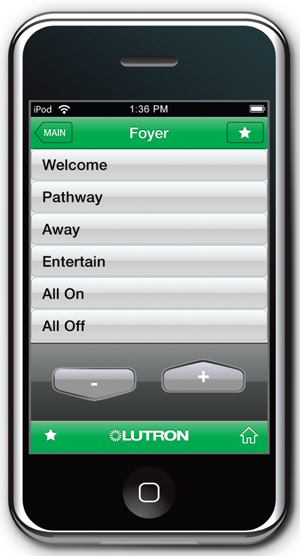Beta tests show that HomeWorks owners are enjoying iPhone control in two basic ways. One, they use it to select a scene they would typically choose when entering or leaving the home, such as Away mode, in which all lights in the home subsequently power off. HomeWorks and other control systems have long had a telephone interface that allows customers to turn on a Home scene from their cell phone as they pull into the driveway. Scheetz says iPhone “takes that capability to a different dimension and gives you a lot more flexibility.”
Consumers are also using the iPhone as a portable home controller to select music and other options from their personal device—regardless of where they are in the home. Scheetz cites homeowners operating inside lights from the back patio, for example. “It doesn’t matter where you are,” he says. “It’s like a wearable keypad. You have the control wherever, whenever you want.”
The connectivity available in the iPhone and iPod Touch puts the devices into a category all their own. “They’re both a browser and a network device,” says Michael Pyle, CEO and founder of SE2 Labs, which is transitioning from a Windows CE-based controller to the iPhone platform. “As long as you can write a Web page, you can write your own communication for the iPhone,” he says. “Once you launch your own application, it takes over the device and becomes your own.”
Since Apple designs both the software and the devices, there’s a stronger synergy between devices than there is in the Windows world. “As an integrator, you’re not sure if Windows is going to work on that computer with that application because there are so many variables,” he continues. “We’re making the change because, for the price of the iPod Touch, we can get much better performance than we can out of the Windows device—and it’s cheaper.”
Because it’s based on the Mac OS 10 operating system, Savant Systems’ ROSIE is a natural for iPod control. “Until now, in-wall touchpanels have been the mantra of how you manage a home,” says Jim Carroll, president of Savant. We believe the iPhone/iPod Touch is a game-changer. We’re not just using the Web browsers in the devices; we reduce the dependency on those in-wall touchpanels.”
Dedicated ROSIE touchscreens range in price from $1,050 to $5,600, but the company pits the iPhone as a replacement for the 5-inch to 7-inch in-wall touchpanel. That delivers significant savings to homeowners. “If you have three people living in a home, you may have eight touchpanels today, but you may only really need three touch-panels, plus the personal device that each person uses,” Carroll explains. “The formula change with the iPhone is pretty significant.”
It’s not just the manufacturers, homeowners, and integrators who like the cool factor of iPhone control. It allows interior designers to eliminate touchpanels from the wall in secondary rooms and main living areas where they don’t want touchscreens to detract from the décor. “Designers seem to be OK with having touchscreens in home theaters and entryways,” Carroll says, “but they put a lot of time and effort into the look, feel, and feng shui of a room to have a piece of technology hanging out.” Using a mobile controller also eliminates the need for running control wiring and power to a location in the wall, which in turn does away with the need for repainting or wallpapering if the designer chooses to reposition the panel late in the game.
“Part of the allure of the iPhone control is that it’s a touchscreen that the homeowner already owns or is considering anyway,” says Lutron’s Scheetz. “Instead of having to buy a $1,000 to $2,000 touchscreen to have this kind of control, I can do it on my iPod instead.”
Rebecca Day specializes in writing about home electronics. She can be reached at customhomerd@aol.com.



